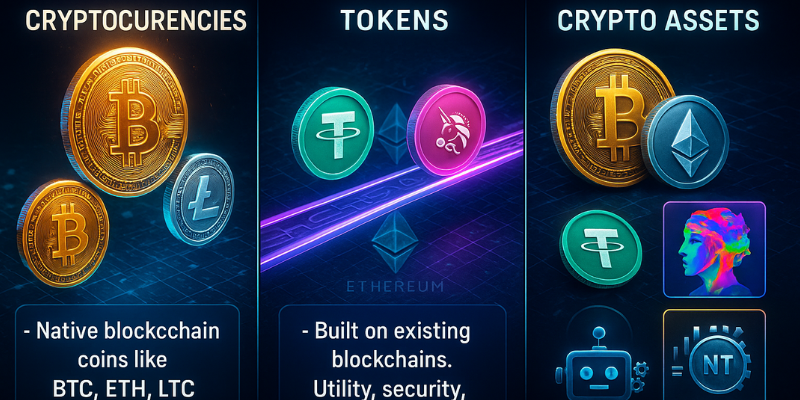The world of crypto can feel like a maze of buzzwords – cryptocurrencies, crypto assets, tokens, and more. Whether you’re diving into crypto trading, investing long-term, or exploring automated trading with a crypto trading bot, understanding these terms is essential.
Let’s break down the basics and see how it all connects to popular trends like cryptobot strategies, DeFi, and trading on modern crypto platforms.
What are cryptocurrencies?
Cryptocurrencies are digital money-think Bitcoin, Ethereum, or Litecoin. These are:
✅ Native to a blockchain – Bitcoin runs on the Bitcoin blockchain, ETH on Ethereum
✅ Used as currency – People use them to send, receive, or store value
✅ Decentralized – Not controlled by any central authority or government
Cryptocurrencies are commonly traded for profit. Many traders now automate this process using crypto trading bots like Junglebot to execute buy/sell decisions with precision and speed.
What are tokens?
Tokens are digital assets built on top of existing blockchains. They don’t have their own blockchain like Bitcoin or Ethereum—they ride on others.
For example:
- USDT (Tether) is a token built on Ethereum
- Uniswap’s UNI token also runs on Ethereum
Types of tokens
Tokens can be classified into several categories:
🔹 Utility tokens – Used within a project’s ecosystem (e.g., for transaction fees, governance voting)
🔹 Security tokens – Represent ownership in an asset, like stocks or real estate
🔹 Stablecoins – Pegged to real-world assets (e.g., USDT, USDC)
Tokens are crucial in DeFi and are heavily used in crypto trading strategies. Many cryptocurrency trading bots support token trading, especially on DEXs (decentralized exchanges).
What are crypto assets?
Crypto assets is a broad umbrella term. It includes:
- Cryptocurrencies (e.g., BTC, ETH)
- Tokens (e.g., USDT, UNI)
- NFTs (non-fungible tokens)
All cryptocurrencies are crypto assets, but not all crypto assets are cryptocurrencies.
This distinction is important today as crypto trading platforms evolve to include staking, NFTs, stablecoins, and automated trading tools that manage a wide variety of digital assets.

Crypto trading and automation: how it all fits together
Understanding these distinctions is key if you’re engaging in crypto trading—whether manually or using automation.
Trading cryptocurrencies
You may choose to:
- Buy and hold coins like Bitcoin or Ethereum for long-term growth
- Use a trade bot to execute short-term trades based on technical indicators
Token trading
Most crypto trading bots are designed to trade token pairs like ETH/USDT or newer DeFi projects.
- DEXs are commonly used for token swaps
- Many bots specialize in arbitrage, scalping, or liquidity mining on token markets
Crypto assets in general
Modern crypto trading platforms support more than just coins:
- NFTs
- Stablecoins
- Staking assets
Experienced traders often diversify their strategies across multiple crypto assets using automated systems.
Why trade crypto using bots?
Crypto trading bots are becoming the standard tool for traders, and here’s why:
✅ Bots trade 24/7—no sleep, no emotion
✅ Bots follow logic and rules—removing human error
✅ Bots handle complex strategies—like arbitrage or grid trading—better than manual efforts
Whether you’re trading tokens, coins, or other digital assets, using a crypto trading bot, like Junglebot, can significantly improve your efficiency—especially in fast-moving markets.
Quick recap
Cryptocurrencies – Native blockchain coins like BTC, ETH, LTC
Crypto assets – General term for all digital blockchain-based items (coins, tokens, NFTs)
Tokens – Built on top of existing blockchains, including utility, security, and stablecoins
Whether you’re a beginner exploring crypto investments or a seasoned trader deploying a crypto trading bot, one thing is clear: knowledge is your best asset in this fast-paced space.
Want to step into automated crypto trading and take your strategy to the next level? Start by mastering the terms—then let the Junglebot’s bots do the heavy lifting.

